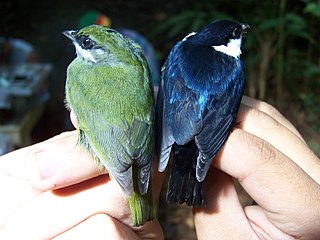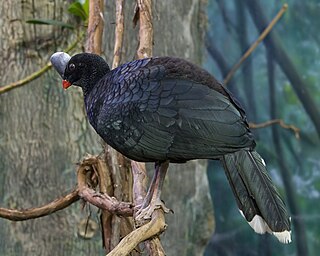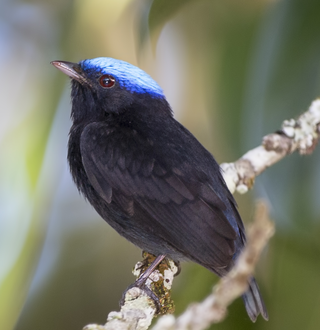
The manakins are a family, Pipridae, of small suboscine passerine birds. The group contains 55 species distributed through the American tropics. The name is from Middle Dutch mannekijn "little man".

Chiroxiphia is one of several genera of manakins, small song birds of South and Central America.

The blue-backed manakin is a small passerine bird which breeds in tropical South America, its range extending from Colombia and Tobago to southeastern Brazil. It is found in deciduous forests but not evergreen rainforests. It is a small, plump bird about 13 centimetres (5 in) long. Males have black plumage with a bright blue back and a red or yellow crown. Females and juveniles are olive-green with paler underparts. At breeding time, males are involved in a cooperative lekking behaviour during which they jump and twirl. This is a fairly common species with a wide range, and the International Union for Conservation of Nature has rated its conservation status as being of "least concern".

The lance-tailed manakin is a small passerine bird which breeds in tropical Central and South America from Costa Rica to northern Venezuela. This manakin is a fairly common bird of dry and moist deciduous forests, but not rainforest. It is a small, compact bird about 13 centimetres (5 in) long and similar to the blue-backed manakin, but both sexes have the two central tail feathers elongated to form a spike. Males have black plumage with a blue back, a red crown and orange legs. Females and juveniles are olive-green with paler underparts. At breeding time, males are involved in a cooperative behaviour during which they jump up and down alternately. This is a fairly common species with a wide range, and the International Union for Conservation of Nature has rated its conservation status as being of "least concern".

The Romualdo Formation is a geologic Konservat-Lagerstätte in northeastern Brazil's Araripe Basin where the states of Pernambuco, Piauí and Ceará come together. The geological formation, previously designated as the Romualdo Member of the Santana Formation, named after the village of Santana do Cariri, lies at the base of the Araripe Plateau. It was discovered by Johann Baptist von Spix in 1819. The strata were deposited during the Aptian stage of the Early Cretaceous in a lacustrine rift basin with shallow marine incursions of the proto-Atlantic. At that time, the South Atlantic was opening up in a long narrow shallow sea.

The orange-collared manakin is a passerine bird in the manakin family. It is an endemic resident breeder in Costa Rica and western Panama, where it is found in forests, secondary growth and plantations. It is a small, plump bird about 10 centimetres (4 in) long. Males have a black crown, mid back, wings and tail and an olive-green rump. The rest of the head, neck, breast and upper back are orange, and the belly is yellow. Females are olive-green with yellow underparts and resemble female white-collared manakins. At breeding time, males are involved in lekking behaviour on the forest floor. This is a fairly common species with a somewhat restricted range, and the International Union for Conservation of Nature has rated its conservation status as being of "least concern".

The white-ruffed manakin is a sub-oscine (Tyranni), passerine bird in the manakin family. It is a resident breeder in the tropical New World from eastern Honduras to northwestern Colombia. Its typical habitat is wet forest, adjacent clearings and tall secondary growth. It is a small, plump bird about 10 centimetres (4 in) long. Males have glossy blue-black plumage with a white erectile ruff on the throat and females are green. At breeding time, males are involved in lekking behaviour on the forest floor during which they puff out their neck feathers. This is a fairly common species with a wide range.

The white-crowned manakin is a small passerine bird in the manakin family Pipridae. This common and extremely widespread manakin is one of the most easily identified, even in female plumage. It is a resident breeder in the tropical New World from Costa Rica to northeastern Peru and eastern Brazil. It was traditionally placed in the genus Pipra, but is now placed in its own monotypic genus Pseudopipra. It is a small, compact bird about 10 cm (3.9 in) long. Males have black plumage with a white crown which can be erected as a crest, the only member of the Pipridae to possess both an all-black body and a gleaming white crown. Females and juveniles are olive-green, with a grey head and throat, and greyish-green or olive underparts. At breeding time, males are involved in a lekking behaviour. This is a fairly common species with a wide range, and the International Union for Conservation of Nature has rated its conservation status as being of "least concern".

The helmeted curassow or northern helmeted curassow, is a large terrestrial bird in the family Cracidae found in the subtropical cloud-forest in steep, mountainous regions of western Venezuela and northern Colombia. There are two subspecies found in different mountain ranges. It is a mostly black bird with a white tip to its tail, a red bill and a distinctive grey casque on its forehead. The population of this bird is in decline and the International Union for Conservation of Nature has rated its conservation status as "endangered".

The Caatinga enclaves moist forests is an ecoregion of the Tropical moist forests Biome, and the South American Atlantic Forest biome. It is located in northeastern Brazil.

The Chapada do Araripe, also known as the Serra do Araripe, is a chapada (plateau) in northeastern Brazil. The chapada forms the boundary of Ceará and Pernambuco states, and forms the watershed between the Jaguaribe River of Ceará, which flows northward into the Atlantic, and the much larger basin of the São Francisco River of Pernambuco and neighboring states, which drains eastward into the Atlantic. The Santana Formation, which is rich with fossils from the early Cretaceous, lies at the base of the chapada. The Araripe manakin, a bird only described in 1998, is endemic to Chapada do Araripe.

The blue manakin or swallow-tailed manakin is a small species of bird in the family Pipridae. It is found mainly in the Atlantic Forest of south-eastern Brazil, eastern Paraguay and far north-eastern Argentina. Its typical habitat is wet lowland or montane forest and heavily degraded former forest. Males have a bright blue body, black head wings and tail and a red crown. Females and juveniles are olive-green. At breeding time, males are involved in lekking behaviour when they sing and dance to impress females. This is a common species with a wide range, and the International Union for Conservation of Nature has rated its conservation status as being of "least concern".Blue Back Manakins are widely found in the Main Ridge Forest Reserve on the Caribbean Island Tobago.

The helmeted manakin is a species of small passerine bird in the manakin family Pipridae. Unlike most manakins, a family associated with tropical rainforests, the helmeted manakin inhabits the seasonally dry Cerrado savanna of Central Brazil.

The long-tailed manakin is a species of bird in the family Pipridae native to Central America where it inhabits both wet and dry tropical and subtropical forests. It is a small, plump bird about 10 centimetres (4 in) long. Males have black plumage with a blue back and a red crown, and the two central tail feathers are greatly elongated. Females and juveniles are olive-green with paler underparts. At breeding time, males are involved in a cooperative lekking behaviour with a complex coordinated courtship dance. This is a fairly common species with a wide range, and the International Union for Conservation of Nature has rated its conservation status as being of "least concern".

The pin-tailed manakin is a suboscine species of bird within the manakin family, Pipridae. This species is endemic to the Eastern coast of Brazil within the humid Atlantic Forest, and its range extends from the State of Bahia to the State of Rio Grande Do Sul. The pin-tailed manakin is monotypic within the genus Ilicura, and has no known subspecies. It is a relatively small species that has pronounced sexual dimorphism. Male birds of this species have a bright white neck, chest, auriculars, and flanks. They have black and dark-green wings, with a signature pin shape tail that has a small fork near the tip, helping to give it its common name in English. The males are most easily identified by their characteristically vibrant red fore-crown and rump. The females of this species are a muted green, except for their neck and auriculars—which are light grey, and their cream-colored chest. Both male and female birds of this species share a slightly elongated head shape that gives them a distinguished raised forehead. The pin-tailed manakin's vocalizations are quiet, but resemble a high-pitched “see-see-see” in descending tones.

Lepidothrix is a genus of passerine birds in the manakin family Pipridae. Birds in the genus are predominantly found in South America, but one species, the velvety manakin, also ranges into Central America. The females of this genus have green plumage with yellow bellies, as do some of the males. The remaining males have black plumage with white or blue crowns. Some also have yellow bellies or blue rumps.

The blue-capped manakin is a species of bird in the family Pipridae. The males have a brilliant blue cap; some have black, others have green body plumage, but the relationship between the subspecies is not well understood.

The kinglet manakin or eastern striped manakin is a small South American species of passerine bird in the manakin family Pipridae. It is found in the Atlantic Forest of south eastern Brazil. It was formerly considered conspecific with the striolated manakin with the common name "striped manakin". Males have a bright red crown, which the females lack.





















